

June 2023 NewsletterISSN: 1933-8651
In this issue we present the following articles, news, announcements, and reviews:
|
Articles, Essays, and Reports
News and Announcements
New Exhibit, Webinars, and Books
Book Reviews
|
Commemorating Mark E. Mack's Commitments
and the Mt. Pleasant Plains Cemetery, Washington, DC
By Christopher Fennell

The Mark E. Mack Community Engagement Award was created by the Society for Historical Archaeology to honor those individual researchers or research project teams that exhibit outstanding best practices in community collaboration, engagement, and outreach in their historical archaeology and heritage preservation work. Mack awardees demonstrate a commitment to the representation of and open dialogue with stakeholders in archaeological research, especially descendant, local, and minority communities.
The award commemorates the life and career of Mark E. Mack (1961-2012) and encourages diversity in the profession by cultivating relationships between archaeologists and stakeholder communities. Mack was well known for his work on the New York African Burial Ground project. He was a professor of anthropology at Howard University and curator of the university’s W. Montague Cobb Research Laboratory. Throughout his career, he exemplified many of the qualities we value as best practices in community, stakeholder collaboration (image courtesy of Howard University).
Mack's work and inspiration were also recognized in December 2021 with the unveiling of exhibits commemorating the escape routes of the “Underground Railroad” at Walter Pierce Park in Washington, DC. The exhibit markers were dedicated by descendants of those who were buried at the site when it was Mt. Pleasant Plains Cemetery. Mt. Pleasant was a burial ground where more than 8,400 African-American Washingtonians were laid to rest between 1870 and 1890. The cemetery was established and managed by the Colored Union Benevolent Association, a group created by free African Americans in 1838.
[Read or download this full article here in Adobe .pdf format >>>].
[Return to table of contents]
African Diaspora Communities of the Shawnee National Forest
and Mary R. McCorvie's Civic Engagements
By Mark Wagner
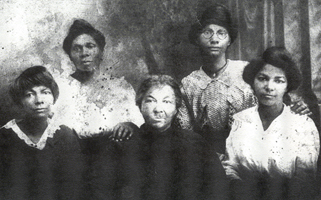
Mary McCorvie and her projects focused on the African diaspora communities of the Shawnee National Forest region received the 2023 Mark E. Mack Award Community Engagement Award by the Society for Historical Archaeology. Mary served as the Heritage Program Manager on the Shawnee National Forest in southern Illinois from 1991 through 2021. During that time she conducted extensive collaborative public outreach programs with African-American, Native-American, and local Euro-American stakeholders to reconnect them with their heritage within Illinois. Her most well-known project involved the pre-Civil War, African-American community called Miller Grove.
Established by freed slaves in the 1840s, the now-abandoned community of Miller Grove consisted of over 20 homesteads, a church, school, and cemetery, all located on a landscape of rolling hills that would later become Forest Service land (Photograph of Abby Gill Miller and her daughters, ca. 1910, above). Mary was instrumental in the preservation of this community though her sponsorship of collaborative investigations into its history, including archaeology and oral history interviews with descendant family members. As part of these initiatives, she directed a multi-year, Historic Black College grant sponsored by the Forest Service headquarters in Washington, DC. This support provided funding for two students to be trained annually in archaeology, historical research, and oral history interviews at Miller Grove. She also developed an "I Too Am America" (ITAA) summer camp program for Miller Grove in which Historic Black College students served as mentors for 324 African-American, 6 Hispanic-American, and 65 Euro-American school children. Adult chaperones and instructors involved in this project totaled an additional 109 participants.
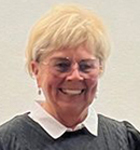
The ITAA summer camps worked to reconnect school children of an underserved area -- deep southern Illinois -- with their heritage by instilling in them a sense of pride in their region. Mary also worked with adult community volunteers, including Americorps "Promise Fellows," the "100 Black Men of America Club," and the African-American Museum of Southern Illinois in the implementation of this program. The Promise Fellows identify and work with 6th to 8th grade students in a one-to-one mentorship to engage students with their community. The 100 Black Men Club mentors similarly seek to develop young people into future leaders by surrounding them with positive influences.
[Read or download this full article here in Adobe .pdf format >>>].
[Return to table of contents]
Interpreting the Domestic Slave Trade: Exhibits and Research at
Alexandria's Freedom House Museum at 1315 Duke Street
By Tatiana Niculescu

In May 2022, the Freedom House Museum reopened in Alexandria. The much-anticipated reopening made regional and national news and marks a new chapter in the history of the site. Two of the three powerful new exhibits showcase archaeological artifacts associated with the lives of free and enslaved Black individuals who lived and passed through Alexandria.
The Freedom House Museum located at 1315 Duke Street is the remains of a large complex through which thousands of Black men, women, and children were trafficked between 1828 and 1861. In the decades before the Civil War, Alexandria was a major port in the domestic trade of enslaved people and a variety of firms operated within the city, forcibly transporting people from the Chesapeake region to the Deep South. At its height, the massive complex spanned nearly half a city block, enclosed by high brick walls and fencing.
The Freedom House Museum seeks to reframe white supremacist history. Slavery, race-based laws, and racial terror erased and diminished African American history and contributions from the national narrative. This museum honors the lives and experiences of the enslaved and free Black people who lived in and were trafficked through Alexandria. Archaeological investigations and artifacts have contributed to the reframing of this narrative.
[Read or download this full article here in Adobe .pdf format >>>].
[Return to table of contents]
"Dwellings of the Enslaved" on Preservation Virginia's
2023 List of Virginia's Most Endangered Historic Places
By Douglas W. Sanford and Dennis J. Pogue

On May 9, Preservation Virginia announced its 2023 listing of the State’s most endangered historic places. Nominated by the Virginia Slave Housing Project, the state-wide listing for "Dwellings of the Enslaved" recognizes the diverse range of threats to surviving examples of domestic housing associated with unfree African Americans (the text of the full nomination is set out below). These buildings represent cultural resources critical for understanding the history of race-based slavery in Virginia and for interpreting descendant communities' heritage. In addition, the same cabins and quarters have significant archaeological components that when excavated and analyzed, allow for more complete and nuanced interpretations of enslaved people's daily lives, resistance to oppression, and their sense of identity.
Begun in 2007, the Virginia Slave Housing Project is co-directed by Douglas W. Sanford, former professor of historic preservation at the University of Mary Washington, and by Dennis J. Pogue, recently retired from the graduate historic preservation program at the University of Maryland, College Park. A major goal of the Project has been to compile comparative data on slave housing from archaeological sites, historic documents (such as fire insurance policies), previous architectural research, and especially, surviving dwellings of the enslaved in rural and urban settings across the State. To date, the Project has documented 120 standing buildings in the field.
Another primary objective centers on promoting the preservation and interpretation of these buildings. Based on our experience over the last 15 years, we realize that the physical survival of slave-related buildings does not equate with preservation. Proactive means of maintenance, repair, and rehabilitation are needed. We hope that Preservation Virginia's listing for "Dwellings of the Enslaved" will encourage local citizens and community organizations to consider steps for identifying, documenting, and preserving the cabins, quarters, and kitchens that formerly housed enslaved Blacks.
[Read or download this full article here in Adobe .pdf format >>>].
[Return to table of contents]
Montpelier Archaeology Recognized with
Society for Historical Archaeology's Roberts Award
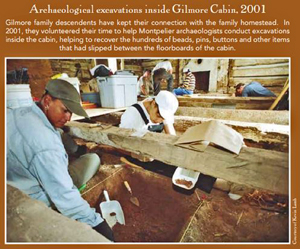
From the Society: "The Daniel G. Roberts Award for Excellence in Public Historical Archaeology was presented to the Montpelier Archaeology Department at the Montpelier Foundation. Nominated by Terry Brock of Wake Forest University, the Montpelier Archaeology Department has been engaged in public archaeology since the early 1990s. Under the leadership of Dr. Matthew Reeves, director of archaeology, the Montpelier Archaeology Department has successfully engaged the public in its work, which has involved extensive outreach and interaction with African American community members, among whom are descendants of those who were enslaved at Montpelier."
"Notably, after Brock had submitted his nomination, the Montpelier Foundation President disengaged from interactions with descendant community members on the Montpelier Board and terminated Reeves and other members of the department. Even more notably -- and a testament to the power of the Montpelier Archaeology program -- the outcry over their termination from the public and the descendant community was so great that the foundation president was replaced and Reeves and his coworkers were reinstated" (SHA Newsletter Spring 2023; image from "The Gilmore Farm Site," by Matthew Reeves and Montpelier Archaeology, African Diaspora Archaeology Newsletter, May 2005).
[Return to table of contents]
Edward González-Tennant's Work on Rosewood Community
Recognized with Society for Historical Archaeology's Cotter Award
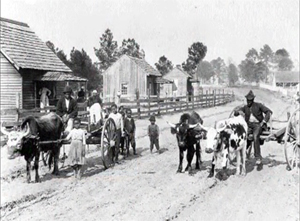
From the Society: "The John C. Cotter Award was presented to Edward González-Tennant by James Davidson of the University of Florida. Presented to scholars in the early stages of their career, Davidson noted that Ed had conducted research on and developed innovative technologies for a range of international historic sites and topics and has been widely published since the receipt of his doctorate in 2011. Ed's work in spatial technologies, GIS, virtual reality, and community engaged, collaborative archaeology are influential and these research tracks coalesced in his work at Rosewood, a Black community in Levy County, Florida, that was destroyed by a violent white mob in January of 1923."

"Denied access to the physical space of the former town of 200, Ed began a virtual reality project that collected written and oral histories of the town and developed a virtual and interactive tour of the town as it appeared in December 1922, shortly before its annihilation. Ed's work resulted in a community-based website and virtual tour of the town (virtualrosewood), provided the basis of his dissertation that in turn was published by the University of Florida Press, and resulted in his being invited to visit and record the Rosewood cemetery, which was surveyed and modeled and added to the Virtual Rosewood website" (SHA Newsletter Spring 2023; images from Remembering Rosewood film by Edward González-Tennant).
[Return to table of contents]
African-American Workers at
Catoctin Furnace Focus of Smithsonian Documentary
By Crystal Schelle
Frederick News Post, May 30, 2023
For centuries, when the history of the Catoctin Furnace was told, it traditionally emphasized its European-decent workers.
But a discovery in 1979 of an African-American cemetery at the furnace and the subsequent years of research have led the Catoctin Furnace Historical Society to tell a different story.
The Smithsonian Channel's "America’s Hidden Stories: Forged in Slavery" documentary shares the story of how enslaved people played a role during the Industrial Revolution, particularly at Catoctin Furnace.
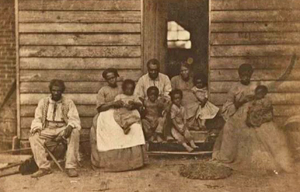
The Catoctin Furnace was established in 1776, a few years after Thomas Johnson Jr., who would become the state’s first governor, discovered a good grade of hematite ore in the Catoctin Mountains. He and Roger Johnson made the furnace to produce pig iron. Over the years, it was converted from charcoal to coal, and it changed hands many times until February 1903, when the furnace was blown for the last time.
The documentary will be shown later in June on the Smithsonian Channel. Comer hopes those who catch "America's Hidden Stories: Forged In Slavery" on the big screen this month will be exposed to history, particularly African-American history, in a new way. "I hope they leave with the same humbling recognition that the African-American community … in this country established, created and made the wealth [and] the power of the country," she said.
[Read this full article online >>>].
[Return to table of contents]
Open Access Articles on JADAH
The Journal of African Diaspora Archaeology and Heritage (Taylor & Francis Press) includes open access articles. You can find these on the journal website (link). Examples of articles currently available with free access include:
"Women, Slavery, and Labor in the United States" by Lydia Wilson Marshall. Abstract: "I have as much muscle as any man, and can do as much work as any man. I have plowed and reaped and husked and chopped and mowed, and can any man do more than that?" – Sojourner Truth, 1851. From the country's founding, the United States' dominant European-American culture included a patriarchal ideology which imposed a simplifying gender binary of male and female. Yet, when intertwined with the impacts of enslavement and racism, this ideology classified and treated African American women starkly differently from white women; it denied them any relative privileges of their gender. Enslaved Black women in the United States routinely did the same kinds of work as their male counterparts. Many women labored in agricultural fields; they even formed the majority of fieldworkers in some cases, such as with rice cultivation in South Carolina. Cast into "male categories," Black women were thus blocked from participation in the U.S. cult of domesticity in which white women of enough financial means avoided physical labor as part of their claim to femininity. Black women's de-gendering is also clearly tied to race's increasing entrenchment in an economic system dependent on enslaved labor. Black women's de-gendering experience under slavery remains central to the development of Black feminist thought across the disciplines; specifically, theorists argue that, thus denied their identity by enslavers, Black women formed new gender constructs and new definitions of motherhood. Keywords: women, slavery, Black feminism, gender, labor, domesticity (link).
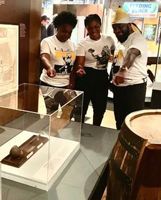 "Chatoyer's Punch Ladle: A Museum Artifact that Speaks to the Hidden History of the Garifuna, An African-Caribbean People," by Christina Welch and Niall Finneran. Abstract: This paper contextualizes the artifact "Punch Ladle, 1773" on display in the "London, Sugar & Slavery" exhibition at Museum of London Docklands (UK). A placard identifies the ladle as once belonging to "Chatoyer, Chief of the Caribs" and as on loan by the West India Committee. Through this artifact, the largely forgotten story of Chatoyer and the so-called Black Caribs (Garifuna) is highlighted, while complexities of the artifact's provenance are analyzed through an object biography approach. The paper also considers the ethical and curatorial implications of the current non-repatriation of the artifact and its present location within the "Slave Owner" part of the exhibition. Finally, by arguing for the artifact's global significance through its association with Chatoyer, a historic African-Caribbean figure of colonial resistance, this article contributes to current museum decolonization debates. Keywords: Object biography, repatriation, St. Vincent, African-Caribbean, Garifuna, Chatoyer, decolonization, curatorial space (link).
"Chatoyer's Punch Ladle: A Museum Artifact that Speaks to the Hidden History of the Garifuna, An African-Caribbean People," by Christina Welch and Niall Finneran. Abstract: This paper contextualizes the artifact "Punch Ladle, 1773" on display in the "London, Sugar & Slavery" exhibition at Museum of London Docklands (UK). A placard identifies the ladle as once belonging to "Chatoyer, Chief of the Caribs" and as on loan by the West India Committee. Through this artifact, the largely forgotten story of Chatoyer and the so-called Black Caribs (Garifuna) is highlighted, while complexities of the artifact's provenance are analyzed through an object biography approach. The paper also considers the ethical and curatorial implications of the current non-repatriation of the artifact and its present location within the "Slave Owner" part of the exhibition. Finally, by arguing for the artifact's global significance through its association with Chatoyer, a historic African-Caribbean figure of colonial resistance, this article contributes to current museum decolonization debates. Keywords: Object biography, repatriation, St. Vincent, African-Caribbean, Garifuna, Chatoyer, decolonization, curatorial space (link).
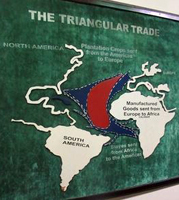 "Localizing the Narrative: The Representation of the Slave Trade and Enslavement Within Nigerian Museums," by Faye Sayer. Abstract: This paper explores the interpretation and presentation of the transatlantic slave trade in Nigerian museums. It focuses on two contrasting case studies, namely the government-funded Slave History Museum (Calabar) and the privately run Seriki Faremi Williams Abass Slave Museum (Badagry). To investigate the complex and conflicting national and local narrative frameworks by which the slave trade and enslavement are presented to the public, this study focuses on qualitative content analysis of museum displays in addition to visitor observations. Comparative analysis of these museums suggests that this historically complex and emotional heritage cannot be understood in isolation from wider local, national, or global narratives. The paper explores the importance of taking a humanizing and empathetic approach to the presentation of the transatlantic slave trade in museums. I also consider how future practice might include ideas of localization and personalization to decolonize "official" slave trade heritage narratives in Nigeria and beyond. Keywords: Museums, slavery, Nigeria, heritage, transatlantic slave trade, localization, decolonization, descendant communities (link).
"Localizing the Narrative: The Representation of the Slave Trade and Enslavement Within Nigerian Museums," by Faye Sayer. Abstract: This paper explores the interpretation and presentation of the transatlantic slave trade in Nigerian museums. It focuses on two contrasting case studies, namely the government-funded Slave History Museum (Calabar) and the privately run Seriki Faremi Williams Abass Slave Museum (Badagry). To investigate the complex and conflicting national and local narrative frameworks by which the slave trade and enslavement are presented to the public, this study focuses on qualitative content analysis of museum displays in addition to visitor observations. Comparative analysis of these museums suggests that this historically complex and emotional heritage cannot be understood in isolation from wider local, national, or global narratives. The paper explores the importance of taking a humanizing and empathetic approach to the presentation of the transatlantic slave trade in museums. I also consider how future practice might include ideas of localization and personalization to decolonize "official" slave trade heritage narratives in Nigeria and beyond. Keywords: Museums, slavery, Nigeria, heritage, transatlantic slave trade, localization, decolonization, descendant communities (link).
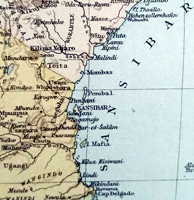 "'Looking for Life': Traces of Slavery in the Structures and Social Lives of Southern Swahili Towns," by Felicitas Becker. Abstract: This article traces the history of slavery and of post-slavery struggles for livelihood and status in the layout, the physical structures, and the social lives of three towns on the southern Swahili Coast: Kilwa, Mikindani, and Lindi. These towns were long surrounded by plantations that relied on the labor of enslaved people. In the first decades of the twentieth century, slave populations dissipated quickly. In towns, the colonial cash crop economy, voluntary rural-urban migration, and the decline of slave-owning elites combined to allow former slaves to assimilate and adopt new urbanite identities. Sufi orders played a central role in affording ex-slaves a respectable presence in town. Nevertheless, former slave owners and former slaves lived in different parts of these towns, former slaves' livelihoods were more precarious, and the imputation of slave origins remains offensive, even today. Indeed, the era of slavery still divides people and still engages the social imagination. Keywords: East Africa, slavery, post-slavery, Sufism, Islam, inequality, urban geography, villagization (link).
"'Looking for Life': Traces of Slavery in the Structures and Social Lives of Southern Swahili Towns," by Felicitas Becker. Abstract: This article traces the history of slavery and of post-slavery struggles for livelihood and status in the layout, the physical structures, and the social lives of three towns on the southern Swahili Coast: Kilwa, Mikindani, and Lindi. These towns were long surrounded by plantations that relied on the labor of enslaved people. In the first decades of the twentieth century, slave populations dissipated quickly. In towns, the colonial cash crop economy, voluntary rural-urban migration, and the decline of slave-owning elites combined to allow former slaves to assimilate and adopt new urbanite identities. Sufi orders played a central role in affording ex-slaves a respectable presence in town. Nevertheless, former slave owners and former slaves lived in different parts of these towns, former slaves' livelihoods were more precarious, and the imputation of slave origins remains offensive, even today. Indeed, the era of slavery still divides people and still engages the social imagination. Keywords: East Africa, slavery, post-slavery, Sufism, Islam, inequality, urban geography, villagization (link).
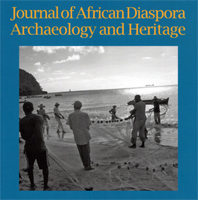 "African Diaspora Foodways in Social and Cultural Context" by Lydia Wilson Marshall. Abstract: African diaspora foodways stand at a crossroads between necessity and expression, biology and culture, sustenance and pleasure. Eating is a biological imperative. But foods are also deeply imbued with cultural meaning. Enslaved African and African American cooks in the Americas created meals that reflected their varied African homelands as well as European and Native American influences. Indeed, scholars have argued this culinary creolization began before enslaved people reached the New World; captives were provided a mixture of culturally familiar and unfamiliar provisions on ships, including American-grown crops like maize. Even under the extreme and deprived conditions of the Middle Passage, newly enslaved people exercised agency in relation to their food consumption. Keywords: cuisine, foodways, culinary traditions, slavery, agency (link).
"African Diaspora Foodways in Social and Cultural Context" by Lydia Wilson Marshall. Abstract: African diaspora foodways stand at a crossroads between necessity and expression, biology and culture, sustenance and pleasure. Eating is a biological imperative. But foods are also deeply imbued with cultural meaning. Enslaved African and African American cooks in the Americas created meals that reflected their varied African homelands as well as European and Native American influences. Indeed, scholars have argued this culinary creolization began before enslaved people reached the New World; captives were provided a mixture of culturally familiar and unfamiliar provisions on ships, including American-grown crops like maize. Even under the extreme and deprived conditions of the Middle Passage, newly enslaved people exercised agency in relation to their food consumption. Keywords: cuisine, foodways, culinary traditions, slavery, agency (link).
The Journal provides a focal point for peer-reviewed publications in interdisciplinary studies in archaeology, history, material culture, and heritage dynamics concerning African descendant populations and cultures across the globe. We welcome articles on broad topics, including the historical processes of culture, economics, gender, power, and racialization operating within and upon African descendant communities. We seek to engage scholarly, professional, and community perspectives on the social dynamics and historical legacies of African descendant cultures and communities worldwide.
[Return to table of contents]
African-American Sites on National Trust
for Historic Preservation's Endangered Lists

The National Trust for Historic Preservation creates annual lists of the 11 most endanger historical sites in the United States. Recent lists have included numerous sites of African-American heritage and significance.
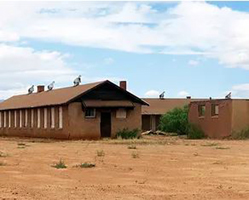
For example, the Trust's list for 2023 includes: Pierce Chapel African Cemetery, Midland, Georgia; West Bank of St. John the Baptist Parish, Louisiana; Holy Aid and Comfort Spiritual Church, New Orleans, Louisiana (aka Perseverance Benevolent and Mutual Aid Society Hall); L.V. Hull Home and Studio, Kosciusko, Mississippi; Henry Ossawa Tanner House, Philadelphia, Pennsylvania; and Charleston’s Historic Neighborhoods, South Carolina. Learn more about these sites online.
The Trust's 2022 list included: Brown Chapel AME Church, Selma, Alabama; Camp Naco, Naco, Arizona; Palmer Memorial Institute, Sedalia, North Carolina; and Olivewood Cemetery, Houston, Texas. Learn more about these sites online.
Explore multimedia profiles of the Olivewood Cemetery, Dr. Susan La Flesche Picotte Memorial Hospital, and Camp Naco.
[Return to table of contents]
International African American Museum
Opens in Charleston, South Carolina
After more than 20 years of planning, the International African American Museum at 14 Wharfside Street in Charleston, South Carolina, is scheduled to open on June 27, 2023, just after "Juneteenth."
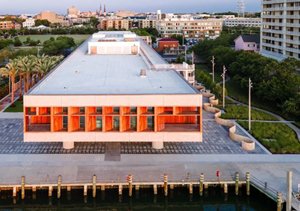
BBC News comments: "The IAAM chronicles the history of Africans' earliest enslavement, starting in 300 BCE, and is built at Gadsden's Wharf, which was once one of the most prolific slave-trading ports in the US. The $100m building rests atop a series of 18 stilts and is designed to not touch the ground in a sign of respect for the enslaved people who once walked the land below. Inside, a permanent collection of 300 artworks and historical artefacts tells the story of the Middle Passage, in which millions of Africans were captured and forcibly brought across the Atlantic."
From IAAM: "To honor the untold stories of the African American journey at one of our country's most sacred sites. The museum documents the journey that began in Africa centuries ago, and still continues today. At our entrance, the African Ancestors Memorial Garden sprawls across the grounds and reflects on the significance of the historically sacred site of Gadsden’s Wharf -- the point at which an estimated 45 percent of enslaved Africans entered this country. Inside, exhibitions tell the unvarnished story of the international African American experience. This is a museum where you can create your own experience -- from quiet reflection in the African Ancestors Memorial Garden to an immersive, eye-opening tour through our galleries to transformative discoveries in the Center for Family History."
"Its nine distinct galleries will demonstrate how enslaved Africans and free blacks shaped economic, political, and cultural development throughout the nation and beyond, while offering an especially close look at the connection to the South Carolina Lowcountry. These include the Transatlantic Experience, the Atlantic Worlds Gallery, the South Carolina Connections Gallery, the Gullah Geechee Gallery, the American Journeys Gallery, the Carolina Gold Gallery, the African Roots Gallery, The Theater, and the Special Exhibitions Gallery."
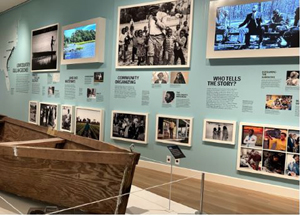
"In addition to the galleries, the African Ancestors Memorial Garden sprawls across the museum’s grounds and reflects on the historic significance of Gadsden’s Wharf, one of the many docks in Charleston Harbor at which an estimated 45% of enslaved Africans entered this country. Artistic installations and site objects mark the history and archeology there. This area, which will be free and open to the public, also provides a space for informal and structured gatherings where stories and traditions can once again be shared."
"Working to serve and improve equity for Black and African Americans, IAAM is a champion of authentic, empathetic storytelling of American history and is thus one of the nation’s newest platforms for the disruption of institutionalized racism as it evolves today."
[Return to table of contents]
Graduate Programs in African Diaspora Archaeology
By Christopher Fennell

This catalog presents a compiled list of graduate school programs that can provide concentration in African diaspora archaeology. There are currently very few programs that formally offer a graduate degree specializing in this subject area, but there exist many programs that offer graduate degrees in archaeology which have faculty who specialize in African diaspora studies. The list set out below was compiled based on published directories, information provided by the departments, and details sent to the author. This list of programs and of related faculty within each program focuses on the US and UK and is not exhaustive or a full compilation of all departments. Other programs can be found at universities in locations, for example, in the Caribbean and South America. If you are aware of other graduate programs in African diaspora archaeology not listed below, or of additional details concerning those that are listed, please contact the author so he can include such information in future compilations.
[Read or download this full article here in Adobe .pdf format >>>].
[Return to table of contents]
New Exhibit
Sacred Diagrams: Haitian Vodou Flags from the Gessen Collection
Tampa Museum of Art, May 7 to August 15, 2023.
The Haitian Cultural Arts Alliance presents
a Haitian Heritage Month exhibition.
Description from the Alliance:
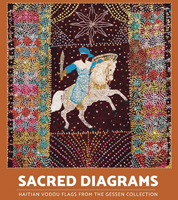 Sacred Diagrams: Haitian Vodou Flags from The Gessen Collection was organized by Edouard Duval-Carrié and Joanna Robotham for the Tampa Museum of Art. The exhibition was brought to The Little Haiti Cultural Complex by the Haitian Cultural Arts Alliance. Special thanks to the Tampa Museum of Art and to Ed Gessen for graciously providing these important works. This exhibition is in homage to Ann Gessen.
Sacred Diagrams: Haitian Vodou Flags from The Gessen Collection was organized by Edouard Duval-Carrié and Joanna Robotham for the Tampa Museum of Art. The exhibition was brought to The Little Haiti Cultural Complex by the Haitian Cultural Arts Alliance. Special thanks to the Tampa Museum of Art and to Ed Gessen for graciously providing these important works. This exhibition is in homage to Ann Gessen.
The related exhibition, Sequin Arts: The Flagmakers of Haiti, is presented in four parts: (1) Vintage Drapo Vodou / (2) The Many Faces of Lwa Ogun / (3) Drapos as Banners / and (4) Artists Using the Medium as Expression. These artists include Clotaire Bazile, Myrlande Constant, Lherison Debreus, Mireille Delice, Edgar Jean-Louis, Silvia Joseph, Antoine Oleyant, Yves Telemak, and Georges Valris (link).
[Return to table of contents]
New Webinars
World Heritage USA "Monuments Toolkit" Project
Overview from World Heritage USA:
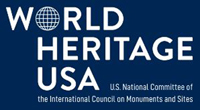 Over the last several years, the intersection of heritage, governance, and how citizens interact with pieces of the past has been present in the public eye. Americans all across the nation are beginning to question the history around them, and many are noticing that the monuments and historic fixtures in their communities are unsolicited reminders of a darker time in our nation’s history.
Over the last several years, the intersection of heritage, governance, and how citizens interact with pieces of the past has been present in the public eye. Americans all across the nation are beginning to question the history around them, and many are noticing that the monuments and historic fixtures in their communities are unsolicited reminders of a darker time in our nation’s history.
The United States Committee of the International Council on Monuments and Sites (World Heritage USA) has been awarded a grant by The Andrew W. Mellon Foundation to support the development of the Monuments Toolkit, a website and app aimed at answering questions about monuments of oppression.
Upon completion of this project we will have interactive maps, resources pages, decision guides, blogs, podcasts, and all of the other fantastic features at your fingertips. Creating accessible spaces to learn about the past puts society’s best foot forward for safeguarding our future.
2023 Webinars include (at Eastern Standard Time):
- The Politics of Monument Removal, Wednesday, June 14, 3:00pm
- The Destruction of Oppressive Monuments Against Indigenous Peoples, Thursday, July 27, 2:00pm
- The Conservation of Oppressive Monuments, Tuesday, August 22, 2:00pm
- Monuments of Oppression in the Museum Space II, Wednesday, September 27, 3:00pm
- Monuments of Oppression in Spaces of Regional Conflict II, Friday, October 20, 1:00pm
- Centering Oppressive Spaces with Digital Media II, Tuesday, November 21, 3:00pm
- Grassroots Projects in Public Spaces, Wednesday, December 7, 2:00pm
Register and participate.
[Return to table of contents]
New Book
Relocating the Sacred: African Divinities and Brazilian Cultural Hybridities
By Niyi Afolabi
State University of New York Press
356 pp., ISBN-13: 978-1438490717, 2022.
Description from the Publisher:
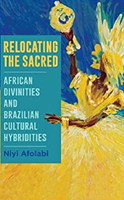 Although Brazil is home to the largest African diaspora, the religions of its African descendants have often been syncretized and submerged, first under the force of colonialism and enslavement and later under the spurious banner of a harmonious national Brazilian character. Relocating the Sacred argues that these religions nevertheless have been preserved and manifested in a strategic corpus of shifting masks and masquerades of Afro-Brazilian identity. Following the re-Africanization process and black consciousness movement of the 1970s to 1990s, Afro-Brazilians have questioned racial democracy, seeing how its claim to harmony actually dispossesses them of political power. By embracing African deities as a source of creative inspiration and resistance, Afro-Brazilians have appropriated syncretism as a means of not only popularizing African culture but also decolonizing themselves from the past shame of slavery. This book maps the role of African heritage in-and relocation of the sacred to-three sites of Brazilian cultural production: ritual altars, literature, and carnival culture.
Although Brazil is home to the largest African diaspora, the religions of its African descendants have often been syncretized and submerged, first under the force of colonialism and enslavement and later under the spurious banner of a harmonious national Brazilian character. Relocating the Sacred argues that these religions nevertheless have been preserved and manifested in a strategic corpus of shifting masks and masquerades of Afro-Brazilian identity. Following the re-Africanization process and black consciousness movement of the 1970s to 1990s, Afro-Brazilians have questioned racial democracy, seeing how its claim to harmony actually dispossesses them of political power. By embracing African deities as a source of creative inspiration and resistance, Afro-Brazilians have appropriated syncretism as a means of not only popularizing African culture but also decolonizing themselves from the past shame of slavery. This book maps the role of African heritage in-and relocation of the sacred to-three sites of Brazilian cultural production: ritual altars, literature, and carnival culture.
[Return to table of contents]
New Book
Souls Grown Deep like the Rivers: Black Artists from the American South
Edited by Maxwell L. Anderson, Paul Goodwin, and Raina Lampkins-Fielder
Royal Academy of Arts
141 pp., ISBN-13: 978-1912520954, 2023.
Description from the Publisher:
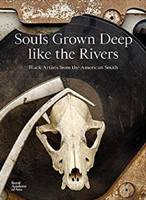 A wide-ranging survey of Black art in the American South, from Thornton Dial and Nellie Mae Rowe to the quilters of Gee's Bend.
A wide-ranging survey of Black art in the American South, from Thornton Dial and Nellie Mae Rowe to the quilters of Gee's Bend.
For generations, Black artists from the American South have forged a unique art tradition. Working in near isolation from established practices, they have created masterpieces in clay, driftwood, roots, soil, and recycled and cast-off objects that articulate America's painful past-the inhuman practice of enslavement, the cruel segregationist policies of the Jim Crow era and institutionalized racism. Their works respond to issues ranging from economic inequality, oppression and social marginalization to sexuality, the influence of place and ancestral memory.
Among the sculptures, paintings, reliefs and drawings included here-the majority from the Souls Grown Deep Foundation in Atlanta-are works by Thornton Dial, Lonnie Holley, Ronald Lockett, Hawkins Bolden, Bessie Harvey, Charles Williams, Mary T. Smith, Purvis Young, Mose Tolliver, Nellie Mae Rowe, Mary Lee Bendolph, Marlene Bennett Jones, Martha Jane Pettway, Loretta Pettway and Henry and Georgia Speller. Also featured are the celebrated quiltmakers of Gee's Bend, Alabama, and work from the neighboring communities of Rehoboth and Alberta.
[Return to table of contents]
New Book
A Movement in Every Direction: Legacies of the Great Migration
Edited by Jessica Bell Brown and Ryan N. Dennis
Yale University Press
152 pp., ISBN-13: 978-0300265736, 2022.
Description from the Publisher:
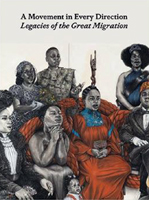 Contemporary artists and writers reflect on the Great Migration and the ways that it continues to inform the Black experience in America.
Contemporary artists and writers reflect on the Great Migration and the ways that it continues to inform the Black experience in America.
The Great Migration (1915–70) saw more than six million African Americans leave the South for destinations across the United States. This incredible dispersal of people across the country transformed nearly every aspect of Black life and culture. Offering a new perspective on this historical phenomenon, this incisive volume presents immersive photography of newly commissioned works of art by Akea, Mark Bradford, Zoë Charlton, Larry W. Cook, Torkwase Dyson, Theaster Gates Jr., Allison Janae Hamilton, Leslie Hewitt, Steffani Jemison, Robert Pruitt, Jamea Richmond-Edwards, and Carrie Mae Weems. The artists investigate their connections to the Deep South through familial stories of perseverance, self-determination, and self-reliance and consider how this history informs their working practices. Essays by Kiese Laymon, Jessica Lynne, Sharifa Rhodes-Pitts, and Willie Jamaal Wright explore how the Great Migration continues to reverberate today in the public and private spheres and examine migration as both a historical and a political consequence, as well as a possibility for reclaiming agency. Published in association with the Baltimore Museum of Art and the Mississippi Museum of Art.
[Return to table of contents]
New Book
The Sacred Language of the Abakuá
By Lydia Cabrera. Edited and translated by Ivor Miller and P. González Gómes-Cásseres
University Press of Mississippi
462 pp., ISBN-13: 978-1496829498, 2020.
Description from the Publisher:
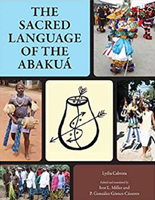 In 1988, Lydia Cabrera (1899–1991) published La lengua sagrada de los Ñáñigos, an Abakuá phrasebook that is to this day the largest work available on any African diaspora community in the Americas. In the early 1800s in Cuba, enslaved Africans from the Cross River region of southeastern Nigeria and southwestern Cameroon created Abakuáá societies for protection and mutual aid. Abakuá rites reenact mythic legends of the institution's history in Africa, using dance, chants, drumming, symbolic writing, herbs, domestic animals, and masked performers to represent African ancestors. Criminalized and scorned in the colonial era, Abakuá members were at the same time contributing to the creation of a unique Cuban culture, including rumba music, now considered a national treasure.
In 1988, Lydia Cabrera (1899–1991) published La lengua sagrada de los Ñáñigos, an Abakuá phrasebook that is to this day the largest work available on any African diaspora community in the Americas. In the early 1800s in Cuba, enslaved Africans from the Cross River region of southeastern Nigeria and southwestern Cameroon created Abakuáá societies for protection and mutual aid. Abakuá rites reenact mythic legends of the institution's history in Africa, using dance, chants, drumming, symbolic writing, herbs, domestic animals, and masked performers to represent African ancestors. Criminalized and scorned in the colonial era, Abakuá members were at the same time contributing to the creation of a unique Cuban culture, including rumba music, now considered a national treasure.
Translated for the first time into English, Cabrera's lexicon documents phrases vital to the creation of a specific African-derived identity in Cuba and presents the first "insider's" view of this African heritage. This text presents thoroughly researched commentaries that link hundreds of entries to the context of mythic rites, skilled ritual performance, and the influence of Abakuá in Cuban society and popular music. Generously illustrated with photographs and drawings, the volume includes a new introduction to Cabrera's writing as well as appendices that situate this important work in Cuba's history.
With the help of living Abakuá specialists in Cuba and the US, Ivor L. Miller and P. González Gómes-Cásseres have translated Cabrera's Spanish into English for the first time while keeping her meanings and cultivated style intact, opening this seminal work to new audiences and propelling its legacy in African diaspora studies.
[Return to table of contents]
New Book
Studying African-Native Americans
Edited by Robert Keith Collins
Routledge Press
122 pp., ISBN-13: 978-1138315259, 2023.
Description from the Publisher:
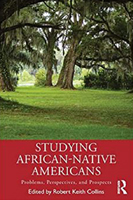 This book examines the academic study of the African and Native American contact, African cultural change in Native America, as well as the existence of African Americans with Native American ancestry and Native Americans with African ancestry in the Western Hemisphere. Drawing upon the fields of anthropology, history, and sociology that initiated research into these areas, this book attempts to provide understandings of how scholars have studied and continue to understand the experiences of African-Native Americans or individuals of blended -- culturally and/or racially -- African and Native American ancestry in the North, Central, and South America.
This book examines the academic study of the African and Native American contact, African cultural change in Native America, as well as the existence of African Americans with Native American ancestry and Native Americans with African ancestry in the Western Hemisphere. Drawing upon the fields of anthropology, history, and sociology that initiated research into these areas, this book attempts to provide understandings of how scholars have studied and continue to understand the experiences of African-Native Americans or individuals of blended -- culturally and/or racially -- African and Native American ancestry in the North, Central, and South America.
It aims to illuminate problems, perspectives, and prospects for interdisciplinary research. The first part is structured to cover the problems -- past and present -- encountered in investigating the scope of the topic and presents an overview of the most important academic findings. The second part provides both anthropological and interdisciplinary perspectives on the lived experiences of African-Native Americans with both Native Americans and non-Native Americans. And, finally, it sketches out future directions in scholarship.
This book will be of interest to anthropologists, historians, sociologists, and Ethnic Studies and Native American and Indigenous Studies scholars, from undergraduates interested in the topic to graduate students and researchers seeking to interrogate past research or fill explanatory gaps in the literature with new research.
[Return to table of contents]
New Book
The Black Reparations Project: A Handbook for Racial Justice
Edited by William Darity, A. Kirsten Mullen, and Lucas Hubbard
University of California Press
258 pp., ISBN-13: 978-0520383814, 2023.
Description from the Publisher:
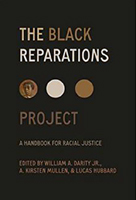 This groundbreaking resource moves us from theory to action with a practical plan for reparations.
This groundbreaking resource moves us from theory to action with a practical plan for reparations.
A surge in interest in black reparations is taking place in America on a scale not seen since the Reconstruction Era. The Black Reparations Project gathers an accomplished interdisciplinary team of scholars -- members of the Reparations Planning Committee -- who have considered the issues pertinent to making reparations happen. This book will be an essential resource in the national conversation going forward.
The first section of The Black Reparations Project crystallizes the rationale for reparations, cataloguing centuries of racial repression, discrimination, violence, mass incarceration, and the immense black-white wealth gap. Drawing on the contributors' expertise in economics, history, law, public policy, public health, and education, the second section unfurls direct guidance for building and implementing a reparations program, including draft legislation that addresses how the program should be financed and how claimants can be identified and compensated. Rigorous and comprehensive, The Black Reparations Project will motivate, guide, and speed the final leg of the journey for justice.
This guidebook builds on an earlier work of William Darity and Kirsten Mullen in From Here to Equality: Reparations for Black Americans in the Twenty-First Century (University of North Carolina Press, 2022).
[Return to table of contents]
New Book
Vigilance: The Life of William Still, Father of the Underground Railroad
By Andrew K. Diemer
Knopf Press
432 pp., ISBN-13: 978-0593534380, 2022.
Description from the Publisher:
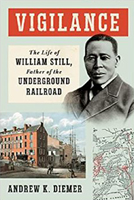 The remarkable and inspiring story of William Still, an unknown abolitionist who dedicated his life to managing a critical section of the Underground Railroad in Philadelphia -- the free state directly north of the Mason-Dixon Line -- helping hundreds of people escape from slavery.
The remarkable and inspiring story of William Still, an unknown abolitionist who dedicated his life to managing a critical section of the Underground Railroad in Philadelphia -- the free state directly north of the Mason-Dixon Line -- helping hundreds of people escape from slavery.
Born free in 1821 to two parents who had been enslaved, William Still was drawn to antislavery work from a young age. Hired as a clerk at the Anti-Slavery office in Philadelphia after teaching himself to read and write, he began directly assisting enslaved people who were crossing over from the South into freedom. Andrew Diemer captures the full range and accomplishments of Still's life, from his resistance to Fugitive Slave Laws and his relationship with John Brown before the war, to his long career fighting for citizenship rights and desegregation until the early twentieth century.
Despite Still's disappearance from history books, during his lifetime he was known as "the Father of the Underground Railroad." Working alongside Harriet Tubman and others at the center of the struggle for Black freedom, Still helped to lay the groundwork for long-lasting activism in the Black community, insisting that the success of their efforts lay not in the work of a few charismatic leaders, but in the cultivation of extensive grassroots networks. Through meticulous research and engaging writing, Vigilance establishes William Still in his rightful place in American history as a major figure of the abolitionist movement.
[Return to table of contents]
New Book
Memories of Africa: Home and Abroad in the United States
By Toyin Falola
University Press of Mississippi
256 pp., ISBN-13: 978-1496843494, 2023.
Description from the Publisher:
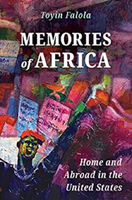 Memories of Africa: Home and Abroad in the United States suggests a new lens for viewing African Diaspora studies: the experiences of African memoirists who live in the United States. The book shows how African Diaspora memoirs beautifully and grippingly depict the experiences of African migrants over time through political, social, and cultural spheres. In reading African Diaspora memoirs from the transatlantic slave trade period to the present, a reader can understand the complexity of the African migrant legacy and evolution.
Memories of Africa: Home and Abroad in the United States suggests a new lens for viewing African Diaspora studies: the experiences of African memoirists who live in the United States. The book shows how African Diaspora memoirs beautifully and grippingly depict the experiences of African migrants over time through political, social, and cultural spheres. In reading African Diaspora memoirs from the transatlantic slave trade period to the present, a reader can understand the complexity of the African migrant legacy and evolution.
Author Toyin Falola argues that memoirs are significant not only in their interpretation of events conveyed by the memoirists but also in demonstrating how interpersonal and human the stories told can be. Memoirs are powerful because they are emotionally captivating and because important themes and events circulate around a particular person (in this case, the memoirist). Undoubtedly, a memoir is significant because it can teach anyone about a part of the human experience, even if the "facts" are not described without bias. Through this sort of narrative, the reader cannot help but enter into the memoirist's mind and, therefore, feel more empathy for them. In doing so, the reader can "feel" what the memoirist feels and "see" what the memoirist sees as clearly as is humanly possible. In this way, the historical events and life lessons become tangible and poignantly real to the reader.
[Return to table of contents]
New Book
Well of Souls: Uncovering the Banjo's Hidden History
By Kristina R. Gaddy
W. W. Norton
304 pp., ISBN-13: 978-0393866803, 2022.
Description from the Publisher:
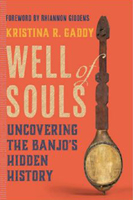 Named one of 2022's Most Memorable Music Books by "No Depression: The Journal of Roots Music." An illuminating history of the banjo, revealing its origins at the crossroads of slavery, religion, and music.
Named one of 2022's Most Memorable Music Books by "No Depression: The Journal of Roots Music." An illuminating history of the banjo, revealing its origins at the crossroads of slavery, religion, and music.
In an extraordinary story unfolding across two hundred years, Kristina Gaddy uncovers the banjo's key role in Black spirituality, ritual, and rebellion. Through meticulous research in diaries, letters, archives, and art, she traces the banjo's beginnings from the seventeenth century, when enslaved people of African descent created it from gourds or calabashes and wood. Gaddy shows how the enslaved carried this unique instrument as they were transported and sold by slaveowners throughout the Americas, to Suriname, the Caribbean, and the colonies that became U.S. states, including Louisiana, South Carolina, Maryland, and New York.
African Americans came together at rituals where the banjo played an essential part. White governments, rightfully afraid that the gatherings could instigate revolt, outlawed them without success. In the mid-nineteenth century, Blackface minstrels appropriated the instrument for their bands, spawning a craze. Eventually the banjo became part of jazz, bluegrass, and country, its deepest history forgotten.
[Return to table of contents]
New Book
Black Lives in Alaska: A History of African Americans in the Far Northwest
By Ian C. Hartman and David Reamer
University of Washington Press
301 pp., ISBN-13: 978-0295750934, 2022.
Description from the Publisher:
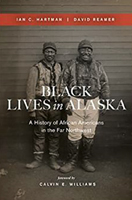 The history of Black Alaskans runs deep and spans generations. Decades before statehood and earlier even than the Klondike gold rush of the 1890s, Black men and women participated in Alaska's politics and culture. They hunted whales, patrolled the seas, built roads, served in the military, and opened businesses, even as they endured racism and fought injustices. Into the twentieth century, Alaska's Black residents were often part of the larger, nationwide freedom struggle. At the same time, Black settlers found themselves in a far different context than elsewhere in the United States, as Alaska's strategic military location, economic reliance on oil, and unique racial landscape influenced how Black Alaskans made a home for themselves in the northwesternmost corner of the country.
The history of Black Alaskans runs deep and spans generations. Decades before statehood and earlier even than the Klondike gold rush of the 1890s, Black men and women participated in Alaska's politics and culture. They hunted whales, patrolled the seas, built roads, served in the military, and opened businesses, even as they endured racism and fought injustices. Into the twentieth century, Alaska's Black residents were often part of the larger, nationwide freedom struggle. At the same time, Black settlers found themselves in a far different context than elsewhere in the United States, as Alaska's strategic military location, economic reliance on oil, and unique racial landscape influenced how Black Alaskans made a home for themselves in the northwesternmost corner of the country.
Centering the agency and diversity of Black Alaskans, Black Lives in Alaska chronicles how Alaska's Black population, though small, has had an outsized impact on the culture and civic life of the region. Alaska's history of race relations and civil rights reminds the reader that the currents of discrimination and its responses-determination, activism, and perseverance-are American stories that might be explored in the unlikeliest of places.
[Return to table of contents]
New Book
Channeling Knowledges: Water and Afro-Diasporic Spirits in Latinx and Caribbean Worlds
By Rebeca L. Hey-Colón
University of Texas Press
280 pp., ISBN-13: 978-1477327258, 2023.
Description from the Publisher:
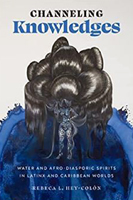 Water is often tasked with upholding division through the imposition of geopolitical borders. We see this in the construction of the Rio Grande/Río Bravo on the US-Mexico border, as well as in how the Caribbean Sea and the Pacific Ocean are used to delineate the limits of US territory. In stark contrast to this divisive view, Afro-diasporic religions conceive of water as a place of connection; it is where spiritual entities and ancestors reside, and where knowledge awaits.
Water is often tasked with upholding division through the imposition of geopolitical borders. We see this in the construction of the Rio Grande/Río Bravo on the US-Mexico border, as well as in how the Caribbean Sea and the Pacific Ocean are used to delineate the limits of US territory. In stark contrast to this divisive view, Afro-diasporic religions conceive of water as a place of connection; it is where spiritual entities and ancestors reside, and where knowledge awaits.
Departing from the premise that water encourages confluence through the sustainment of contradiction, Channeling Knowledges fathoms water's depth and breadth in the work of Latinx and Caribbean creators such as Mayra Santos-Febres, Rita Indiana, Gloria Evangelina Anzaldúa, and the Border of Lights collective. Combining methodologies from literary studies, anthropology, history, and religious studies, Rebeca L. Hey-Colón's interdisciplinary study traces how Latinx and Caribbean cultural production draws on systems of Afro-diasporic worship -- Haitian Vodou, La 21 División (Dominican Vodou), and Santería/Regla de Ocha -- to channel the power of water, both salty and sweet, in sustaining connections between past, present, and not-yet-imagined futures.
[Return to table of contents]
New Book
Slavery in Zion: A Documentary and Genealogical History
of Black Lives and Black Servitude in Utah Territory, 1847-1862
By Amy Tanner Thiriot
University of Utah Press
384 pp., ISBN-13: 978-1647690854, 2023.
Description from the Publisher:
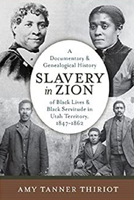 According to an Akan proverb, "It is not wrong to go back for that which you have forgotten." This belief underlies historian Amy Tanner Thiriot's work in Slavery in Zion, which combines genealogical and historical research to bring to light events and relationships unknown or misunderstood for well over a century. The total number of enslaved people in Utah’s early history has remained an open question for many years, due in part to the nature of nineteenth-century records, and an exact number is undetermined. But while writing this book Thiriot documented around one hundred enslaved or indentured Black men, women, and children in Utah Territory.
According to an Akan proverb, "It is not wrong to go back for that which you have forgotten." This belief underlies historian Amy Tanner Thiriot's work in Slavery in Zion, which combines genealogical and historical research to bring to light events and relationships unknown or misunderstood for well over a century. The total number of enslaved people in Utah’s early history has remained an open question for many years, due in part to the nature of nineteenth-century records, and an exact number is undetermined. But while writing this book Thiriot documented around one hundred enslaved or indentured Black men, women, and children in Utah Territory.
Slavery in Zion has two major parts. The first section provides an introductory history, chapters on southern and western experiences, and information on life after emancipation. The second section is a biographical encyclopedia of names, relationships, and events. Although Slavery in Zion contains material applicable to legal history and the history of race and Mormonism, its most important contribution is as an archive of the experiences of Utah's enslaved Black people, at last making their stories an integral part of the record of Utah and the American West—no longer forgotten or written out of history.
[Return to table of contents]
Book Review
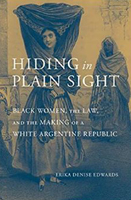
Erika Denise Edwards. Hiding in Plain Sight: Black Women, the Law, and the Making of a White Argentine Republic. Tuscaloosa: University of Alabama Press, 2020. xvi + 168 pp. (Cloth). ISBN 978-0-8173-2036-2.
H-Net Book Review, published by H-Nationalism, https://networks.h-net.org/h-nationalism (July, 2022).
Reviewed for H-Nationalism by Candela Marini (Milwaukee School of Engineering).
Argentina is a country that has consistently disacknowledged the contributions of Black Argentines to the nation's past and present. A commonly held belief states that Afro-descendants simply "disappeared," and many Argentines would find unproblematic the fact that at the end of the nineteenth century racial categories stopped being registered in the national census -- under the assumption that the country would soon be homogenously white. In Hiding in Plain Sight: Black Women, the Law, and the Making of a White Argentine Republic, Erika Denise Edwards studies the roots of this issue, analyzing the methods and processes that help explain how Black Argentines became invisible as the colony became a republic. Moving away from the ever-changing city of Buenos Aires, Edwards studies instead the city of Córdoba in the late eighteenth and early nineteenth centuries, illuminating practices and beliefs that prepared the way for the period of forthright institutionalized whitening (1850-1914).
To understand the origins of this invisibility, Edwards examines race relations in the domestic sphere, focusing on the everyday decisions that Afro-descendants made to "acquire whiteness." Indeed, one of her main arguments is that, in trying to escape "the stigma of blackness" (p. 8), Black women were actors in their own erasure, as they challenged racial hierarchies and pursued ways to ascend the social ladder. Edwards is aware that some may find this "problematic and unfortunate" (p. 115), but she argues that, given the societal and governmental limitations and burdens on blackness, "African-descended women's decisions to transform into Spanish or Indian women or become educated highlight adaptation as a form of resistance" (p. 117).
In the first two chapters, Edwards offers an overview of the political changes that affected the region from the Bourbon reforms to revolution, independence, and the start of the Argentine republic. In this first part we come to understand the hierarchies but also the fluidities of the colonial caste system, and the laws and customs that at times protected families and allowed a certain mobility through the local social structure. Exploiting these fluidities, Black women fashioned identities that positioned them as Indigenous or Spanish rather than Black. This whitening process was mainly pursued through marriage and cohabitation with men of better social standing. The potential of these unstable divisions is exemplified in chapter 3, where Edwards introduces the story of Bernabela, an enslaved woman who became the concubine of the vicar don José Lino (a rather curious individual who reappears in other cases studied in the book). Bernabela was unable to marry the vicar, but the latter "manumitted her, and she managed the household as if she were the señora (lady of the house)" (p. 48), dressing like an elite woman and giving orders to other slaves. In chapters 4 and 5, Edwards studies Black women's attempts to erase blackness by directly claiming Indigenous ancestry and, thus, free status for themselves and their children (though her census data also reveal that marriage between Black and Indigenous groups was not uncommon). Indigeneity was also claimed when parents contested marriages that they deemed "unequal," and thus those accused of having "mala sangre" would argue and prove in court that they were in fact Indigenous or Spanish. The last chapter focuses on the Free Womb Act of the early republic (1813) and the impositions of the new government targeting children of African descent. Studying programs of public education, Edwards argues that ecclesiastical and governmental authorities reinforced among Black girls the notion that whitening was to be desired, educating them according to white notions of morality, virtue, and civility. Adapting and adopting these "white lessons" was thus another strategy to lessen the restrictions imposed on their blackness.
The book's level of archival work is outstanding. Edwards seamlessly moves through ecclesiastical and criminal cases, marriage and baptism records, city censuses, and notarial records. Through these documents, Edwards brings back the voices of Black women who overcame, or attempted to overcome, racial barriers. Edwards's fresh prose accompanies these stories with excitement, a tone introduced by the intimate voice with which she opens the book, sharing her own personal experiences as she first visited Argentina. At times, however, her writing moves quite rapidly through historical processes and concepts that are central to her observations. As a result, the reader may lose sight of the bigger picture, particularly if they are not already familiar with the local history.
Hiding in Plain Sight is a thought-provoking addition to the increasing number of publications dedicated to the study of slavery and the place of Afro-descendants in Argentina. This area of studies has grown noticeably stronger in the last two decades, correcting the old myth of a white Argentina that swiftly eradicated slavery and so too its legacy. Edwards's book dovetails nicely with recent publications such as Cartografías afrolatinoamericanas. Perspectivas situadas desde Argentina, edited by Florencia Guzmán, Lea Geler, and Alejandro Frigerio (2016); María de Lourdes Ghidoli's Estereotipos en negro: representaciones y autorrepresentaciones visuales de afroporteños en el siglo XIX (2016); and Magdalena Candioti's Una historia de la emancipación negra. Esclavitud y abolición en la Argentina (2021). Writing from the University of North Caroline-Charlotte, Edwards continues an academic transhemispheric dialogue on Blackness that George Reid Andrews started with his 1980's The Afro-Argentines of Buenos Aires, 1800-1900. As Edwards says at the very beginning of her book, "I realized that my blackness did not mean the same thing in Argentina as it did in the United States. My blackness, which defines my identity in the United States, became invisible in Argentina" (p. 1). Hiding in Plain Sight thus invites an English-speaking audience to consider different conceptions and histories of race. For Argentine readers, Edwards helps us rethink the formation of Argentina's political body, its limits, and ongoing exclusions.
[Citation: Candela Marini. Review of Edwards, Erika Denise. Hiding in Plain Sight: Black Women, the Law, and the Making of a White Argentine Republic. H-Nationalism, H-Net Reviews. July, 2022. This work is licensed under a Creative Commons Attribution-Noncommercial-No Derivative Works 3.0 United States License. H-Net permits the redistribution and reprinting of this work for nonprofit, educational purposes.]
[Return to table of contents]
Book Review
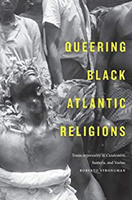
Roberto Strongman. Queering Black Atlantic Religions: Transcorporeality in Candomblé, Santería, and Vodou. Durham: Duke University Press, 2019. xi + 284 pp. (Paperback). ISBN 978-1-4780-0310-6.
H-Net Book Review, published by H-Atlantic, https://networks.h-net.org/h-atlantic (April, 2022).
Reviewed for H-Atlantic by Reviewed by Marietta Kosma (University of Oxford).
In Queering Black Atlantic Religions, Roberto Strongman examines embodiment and sexuality in the context of Black Atlantic religions in Haiti, Cuba, and Brazil. What is interesting is that Strongman employs the intersection of race, gender, and sexuality to shed light on the cultural practices that take place throughout the Black Atlantic world. Strongman's book thus falls into the field of performative studies while engaging with the discourses of colonialism, mimesis, religion, and deconstruction to demonstrate the embodied transgressions of gender and sexuality throughout nineteenth-century America. Strongman also theorizes the notion of transcorporeality through the religious systems of Haitian Vodou, Cuban Lucumí (Santería), and Brazilian Candomblé by showing the connection between the performativity of embodiment and of culture. The dialogue that Strongman creates is innovative because it exposes the non-fixity of subjectivity and the creation of a new social order while disrupting patriarchal structures which exclude mobility along gender lines. Queer studies and feminist scholars also deal with these issues of the non-fixity of embodiment; however, Strongman achieves an interdisciplinary approach that renders this idea of non-fixity accessible to individuals that have not been initiated to the Afro-Atlantic religions.
The book consists of three sections in two chapters each: Vodou, Lucumí/Santería, and Candomblé. The chapters are written from a transnational point of view as Strongman critically engages with materials in multiple languages such as French, Spanish, Kreyòl, and Portuguese. In the three main sections, the notion of transcorporeality is further explored through use of visual arts, more specifically through the critique of films, paintings, and novels. Transcorporeality is framed as a Black externalization of the psyche independent of the constraints of biological sex, which leads to the production of more fluid identities.
In the introduction to the book, the igbodu is summoned. The igbodu is conceptualized as the place in society where secrets are guarded. This concept is linked to the discourses of metaphysics and rituals, which hold an obscure space in our Western conceptualization of Yoruba-inspired religions. Strongman theorizes the idea of the igbodu to illustrate how existing immaterial energy can be turned into a different form of energy in terms of literary creation. However, Strongman disassociates the creation of the igbodu from the bounds of a particular cultural location and extends it to the sphere of the imaginative. In addition, different notions of African and Afro-Caribbean philosophy are explored in relation to the immaterial aspect of subjecthood. It has been argued that "the tibonanj (the part of the psyche that allows for self-reflection and self-criticism) authorizes the gwobonanj (the individual source of memory, intelligence, and personhood) to exit the head in order to accommodate the lwa spirit."[1] This model of this thereby challenges the fixity of gender in heteropatriarchal discourses of subjectivity.
In these three sections, Strongman revises, according to a review by Assumpção B. Costa Pablo, "the queer potential in the canonical scholarship dedicated to each religion."[2] This concept of transcorporeality is thus central to Black Atlantic religions. Strongman in particular focuses on the performative aspect of transcorporeality and links it to cultural materials such as films and media. His engagement with this material exposes an everlasting manifestation of queerness in Black Atlantic religions. Strongman further focuses on the dynamic nature of constructing nonbinary identities by emphasizing the possibility of remaking one's personhood. He also draws a link between consciousness and materiality through emphasizing the mutability of the categories of gender and sexuality in the Vodou tradition.
Meanwhile, in the first section, Strongman critically engages with the discourse of feminist scholars who examine Vodou; more specifically, he engages with the work of Zora Neale Hurston, Maya Deren, and Mimerose Beaubrun, scholars who tackle male ethnography on Vodou. In the second section, Strongman employs a comparative reading of transcorporeality on an ethnographical level. And in the last section, Strongman examines Jorge Amado's novel Dona Flor and Her Two Husbands (1966) and Bruno Barreto's take on these novels through film to reveal the issue of spirituality in Black Brazil. A central question that Strongman poses throughout the three sections is whether the durability of transcorporeality is ultimately linked to the politics of movement. By focusing on the transatlantic voyage in the past and the Black subject's return to Europe in the present, he exposes the possibility of decimating the unitary dimension of one's subjecthood.
In conclusion, Queering Black Atlantic Religions deals with the issue of alternative gender identification in Haitian Vodou, Cuban Lucumí, and Brazilian Candomblé. By employing artistic representations of queerness, Strongman provides an informed discussion about Afro-Atlantic traditions, and the book is an important addition to Black diasporic studies and performative studies due to Strongman's interdisciplinary approach toward gender, religion, and sociocultural studies. The theme of transcorporeality is key, for it informs the existing discourse around queerness and exposes the possibility of creation of a new social order in which the fixity of gender roles is challenged and the transgression of sexual values becomes structural. Strongman's approach is altogether innovative because he links the existing Western discourse of embodiment to the West African philosophical system of embodiment. Strongman thereby critically engages with the religious practices of diasporic communities of the Caribbean and South America and lays the foundation for additional research focusing on transcorporeality.
Notes
[1]. Assumpção B. Costa Pablo, review of Queering Black Atlantic Religions: Transcorporeality in Candomblé, Santería, and Vodou, by Roberto Strongman, Drama Review 64, no. 3 (2020): 176-78, quotation on 176.
[2]. Ibid., 177.
[Citation: Marietta Kosma. Review of Strongman, Roberto. Queering Black Atlantic Religions: Transcorporeality in Candomblé, Santería, and Vodou. H-Atlantic, H-Net Reviews. April, 2022. This work is licensed under a Creative Commons Attribution-Noncommercial-No Derivative Works 3.0 United States License. H-Net permits the redistribution and reprinting of this work for nonprofit, educational purposes.]
[Return to table of contents]
Book Review
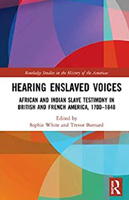
Sophie White and Trevor Burnard, eds. Hearing Enslaved Voices: African and Indian Slave Testimony in British and French America, 1700-1848. Routledge Studies in the History of the Americas Series. New York: Routledge, 2020. 264 pp. (Ebook). ISBN 978-1-00-308812-7.
H-Net Book Review, published by H-Slavery, https://networks.h-net.org/h-slavery (September, 2022).
Reviewed for H-Atlantic by Spencer Gomez (University of California Irvine).
Hearing Enslaved Voices revisits the colonial archives of the two biggest slave empires in the Northern Hemisphere, France and England, to better understand the experiences of enslaved people. The authors challenge the supremacy of autobiographical slave narratives that appear in the nineteenth century, mainly in the American South and Brazil, as well as interviews conducted by the Federal Writers' Project in the United States. These authors claim that expanding the slave narrative genre allows us another avenue to hear the voices of enslaved Africans and Native Americans from between 1700 and 1848. This book emphasizes "alternative types of slave narratives, especially testimony, and interrogates how such narratives were produced, the societies in which testimony was permitted, and the meanings that we can attach to such narratives" (p. 1). This collection is separated into three distinct parts: methodology, Native Americans, and African Americans.
Using the work of previous theorists, such as Saidiya Hartman, Michel Foucault, and Marisa Fuentes, the authors of this book recognize the power that resides in the archives and other statebuilding institutions.[1] In other words, they acknowledge the constraints imposed by the institutions that house the documents, as well as the officials who created and drafted the documents. Yet the authors of these essays do not give up in the "face of the methodological and epistemological problems that the archives produce in trying to recapture the lives of the enslaved" (pp. 3-4). The referenced work of literary theorist Nicole Alijoe, Creole Testimonies: Slave Narratives from the British West Indies, 1700-1838 (2012), helps the edition recapture the voices of enslaved individuals through an understanding of the relationship between oral and written testimonies. Instead of seeing the multiple layers of authorship as a problem, Aljoe urges us to concentrate on the experiences narrated in the text as a means of teasing out the truth by deeply invested writers.
The essays span a variety of geographical locations between the British and French empires in the Americas -- from metropolitan France to New Orleans and New France, to New England in British America, and to parts of the British and French Caribbean -- and cover Native American and African American populations. The similarities between the British and French centered on their strong commitment to both slavery and the plantation system, most represented in the Atlantic slave trade. That commitment was expressed through strong state support of planters and their authority over enslaved peoples. However, the broad similarities did not mean that significant differences did not exist in how each empire decided to regulate and promote slavery. The differences lay often in their regulation, specifically how much latitude was allowed by each empire for the enslaved to talk back to the colonial state. Most important, the British had no overarching slave policy that needed to be obeyed, while the French governed enslaved people of African descent through both local and centralized laws, or the code noir.
In part 1, authors Sophie White, Cécile Vidal, and Dominique Rogers use slave judiciary testimonies throughout New Orleans and the French Caribbean to illustrate the harsh conditions of everyday life for enslaved people. Written testimonies in runaway cases provide a way to hear enslaved voices through multiple layers of intermediators. The testimony of Marguerite, an enslaved woman charged with running away, allows us a glimpse into her mental state through the mockery, anger, and frustration directed at her owner. As mentioned above, enslaved litigants in French territory were able to talk without being immediately interrupted and therefore able to craft stories to defend themselves. The transcripts consistently captured the words and shifting tones of the speaker as court scribes made significant efforts to document altered testimonies. Using these methods, scholars can identify the outbursts, oversharing of information, and extended family and social life that enslaved people used to redefine their situation at court.
In part 2, Linford Fisher, Margaret Ellen Newell, and Brett Rushforth use the methodological approaches from the earlier chapters to reinterpret Indian slavery in North America. Through these testimonies, the reader learns that enslaved Indians used their personal histories, relationships, and language skills to contest the identities placed on them by the colonial state, as shown in chapters 4 and 6. In chapter 5, Newell broadens our understanding of the slave archive to include genres outside the autobiographical slave narratives, to include true-crime tales, the conversion narrative, and sermons. This is designed to offer a creative strategy for uncovering slave narratives that we can use to reconstruct the European-Native American encounter.
In part 3, Aaron Spencer Fogleman, Miranda Spieler, Trevor Burnard, and Anita Rupprecht examine a wide range of topics that concern ideology, legal archives, and moral economies, in both the metropole and colonies. Fogleman takes a statistical approach to the personal narratives produced before and after the Atlantic revolutions. The author highlights the ideologies found within the text and emphasizes the nuanced elements, such as Christian and Muslim ideals, to condemn the transatlantic slave trade. The last three chapters examine multiple points of contention between enslaved people and their respective courts when contesting their freedom and mistreatment. Rupprecht exemplifies this best with her examination of the "captured negroes" in Antigua between 1807 and 1823 (p. 220). Using commission records, she reconstructs other forms of coerced labor created by local officials outside the institution of slavery. The author rightfully concludes that these do not document slavery; rather, they record a significant moment in slavery's unraveling.
Hearing Enslaved Voices offers scholars of the Anglo-Franco Atlantic a revitalized perspective on ways to push the boundaries of the slave narrative genre; it focuses on moving past the kind of "selfrealization" found in autobiographical narratives (p. 227). Instead of recycling the same catalog of classic slave narratives, this book expands our understanding to include testimonies, financial reparations, religious ideology, and Indigenous conversions. Most important, the authors provide a service for interested parties by incorporating specific record names, such as French colonial Louisiana, and their accessibility. Additionally, the authors of the essays in the collection demonstrate a willingness to engage with contemporary scholars, such as Sharon Block and Stephanie Smallwood, as well as foundational ones, like Eric Williams and E. P. Thompson.[2] While the book is targeted to scholars of slavery in North American, empire, and Indigenous studies, it offers digestible essays for scholars in other fields, such as Latin America, with distinct emphasis on race and gender in the late colonial period.
Notes
[1]. Saidiya Hartman, "Venus in Two Acts," Small Axe 26 (June 2008): 1-14; Michel Foucault, "Lives of Infamous Men," in The Essential Foucault, ed. Paul Rabinow and Nikolas Rose (New York: New Press, 2003), 157-75; and Marisa Fuentes, Dispossessed Lives: Enslaved Women, Violence, and the Archive (Philadelphia: University of Pennsylvania Press, 2016).
[2]. Sharon Block, Colonial Complexions: Race and Bodies in Eighteenth-Century America (Philadelphia: University of Pennsylvania Press, 2018); Stephanie Smallwood, Saltwater Slavery: A Middle Passage from Africa to American Diaspora (Cambridge, MA: Harvard University Press, 2007); Eric Williams, "The British West Indian Slave Trade after Its Abolition in 1807," Journal of Negro History 27, no. 2 (1942): 175-91; and E. P. Thompson, "The Moral Economy of the English Crowd," Past & Present 50, no. 1 (1971): 76-136.
Citation: Spencer Gomez. Review of White, Sophie; Burnard, Trevor, eds. Hearing Enslaved Voices: African and Indian Slave Testimony in British and French America, 1700-1848. H-Slavery, H-Net Reviews. September, 2022.
[Return to table of contents]

©2023 African Diaspora Archaeology Network
Copyright and all rights reserved by
individual authors for each article.
Please send comments, suggestions,
or questions to the editor
Last updated: June 2, 2023
Text only menuSearch
|



